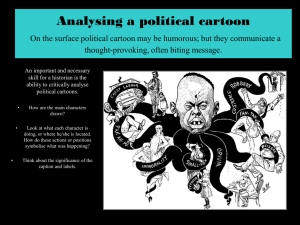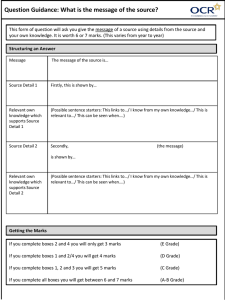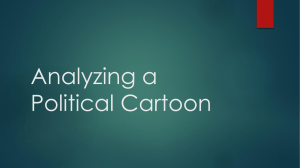28. Symbols in Children`s Lit
advertisement
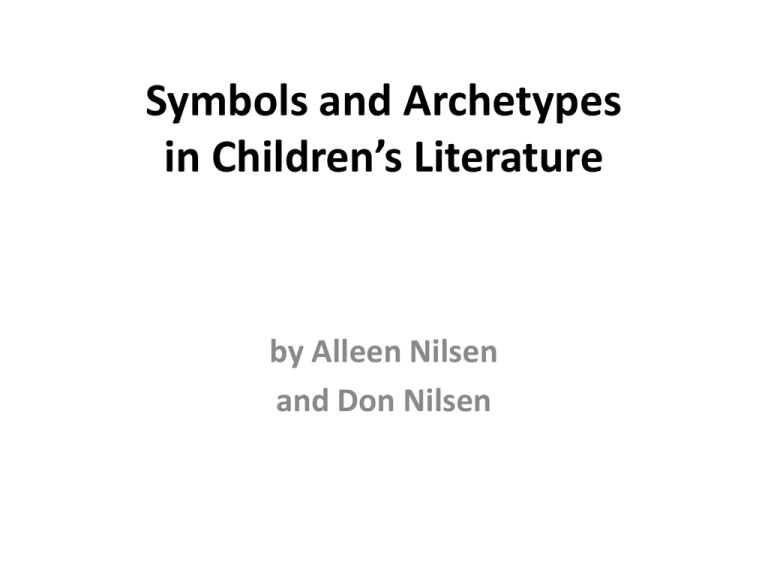
Symbols and Archetypes in Children’s Literature by Alleen Nilsen and Don Nilsen Children’s literature is a good place to look for symbols and archetypes that are important to a culture because: 1. People who create stories and art for children use simple concepts so children will understand them. 2. They rely on common objects, including animals, that fascinate children. 3. Especially in old folktales and rhymes, the “wisdom” of the ages has been collected, condensed, and polished for a new generation. 4. The “classics” of children’s literature are shared by parents, teachers, and various media so nearly all children are “taught” the symbols of their culture. American advertisers, broadcasters, cartoonists, politicians and bloggers rely on these exaggerated characters to make their points: • • • • CHICKEN LITTLE to represent alarmists. PINOCCHIO to stand in for liars. THE BIG BAD WOLF to warn us of danger. HUMPTY DUMPTY to point out how easy it is to fall from grace. • THE FROG PRINCE to give hope to discouraged women of all ages. If they are apt enough, even modern stories work their way into pop cultural symbolism. • The title of Judith Viorst’s popular 1972 book, Alexander and the Terrible, Horrible, No Good Very Bad Day, not only scans well but fits with our national mood so that in the early decade after 9/11, a curious journalist found it used as a metaphor in over 50 prominent news stories. • When he interviewed Viorst about it, she modestly said it was simply because the children who grew up with the book, were now running the U. S. news media. Here Is A Parade of Animal Sayings from a 1969 New Yorker cartoon by Lee Lorenz • LORD LOVE A DUCK • A BEAR FOR PUNISHMENT • • • • • • • I’LL BE A MONKEY’S UNCLE IN A PIG’S EYE THE CAT’S PAJAMAS SEE YOU LATER, ALLIGATOR IT’S A DOG’S LIFE DRUNK AS A SKUNK YOU CAN LEAD A HORSE TO WATER, BUT YOU CAN’T MAKE HIM DRINK • SNUG AS A BUG IN A RUG Many symbols don’t match real life as in this Hershey “Care Bear” delivering a candy kiss. OTHER IMAGINARY BEARS IN CHILDREN’S LIVES: • Teddy bears • Goldilocks and the Three Bears • Getting “a Bear Hug.” • Some children even think that going “Bare Naked” is dressing like a bear. CURIOUS GEORGE is a lovable monkey portrayed in H. A. Rey’s picture books • Because of him, children know what the teacher means when she says, • “No monkey business now!” or “Stop monkeying around!” • He also inspires them as they play on their school’s monkey bars. There’s something cheerful about a smiling Humpty Dumpty sitting on a wall, but still he portends disaster. • We are affected because our emotions are stretched in both directions. • In cartoons, after his fall, there is usually a sympathetic crowd trying to put him back together. • But a surprising cartoon in 2009 showed him being shunned by a donkey and two wizard-like characters shouting “Salmonella!” This New Yorker cartoon is more typical. • It is hinting to a Wall Street banker that there’s going to be a stock market crash. • The “Humpty Dumpty” nursery rhyme is so famous that even without the image, the phrase “And all the King’s men…” is enough to deliver a warning. Our ASU library has over 100 items with these words in the title. Personified animals (sometimes called “people in fur”) are popular because children can identify with them regardless of race and sometimes gender. • Arnold Lobel’s Frog and Toad stories are about two friends relating across ethnic lines. • The two species have different reputations; e.g., if a frog is kissed, he turns into a prince. • But if a toad is kissed, the kisser is predicted to get warts. Even letters of the alphabet take on symbolic meanings as when people talk about learning the ABC’s as seen in this Steve Benson cartoon about Arizona’s school Supt. Even letters of the alphabet can take on extra meanings as in this folk song. • A currently popular TV commercial for Geico shows an old farmer in a spelling bee. • He is supposed to spell COW. • He almost gets it right, but then is expelled when he confidently adds “E-I-E-I-O.” Dorothy and her friends from The Wizard of Oz are popular cartoon characters as shown in this 2014 Steve Benson cartoon in the Arizona Republic. Over the years, the same characters are alluded to with totally different messages. • In the 1980s, AZ Public Service used Dorothy and her friends dancing up the yellow brick road with the message, “We’re on our way to more efficient fuel alternatives.” • In a recent cartoon, The Wicked Witch is saying “Forget the slippers. I want the Tin Man’s oil.” • In another cartoon, Dorothy and friends have sold the Tin Man to a recycling center in exchange for bus fare back to Kansas. “There was an old woman who lived in a shoe. She had so many children She didn’t know what to do.” • Actually, we all live in our shoes, but just not as interpreted in the old nursery rhyme. • In the 1980s, she was featured in a cheerful advertising campaign for Hawaiian punch, which was such a bargain she could afford it for her whole family. But cartoons in 2012 had different messages fitting with changes in the real estate market. • One drawing showed the shoe all boarded up with a “FORECLOSURE” sign on it. • In another one, a real estate broker is standing in front of the shoe and saying “It looked kinda dumpty, but appraised at a million-two.” Hansel and Gretel are the ultimate example of unfortunate orphans. • In one cartoon, Gretel solemnly quizzes the Witch on the nutritional value of the food in her enticing house. • Another shows an ornate drawing of the house with a sign reading “THIS STRUCTURE WILL BE TORN DOWN AND REPLACED BY A NEW 44-STORY COOKIE.” • A fairly recent advertising campaign on television related to financial security showed Hansel and Gretel fearfully wandering into Wall Street and dropping bread crumbs along the way in hopes of finding their way out. Peter Pan is a character in Sir James Barrie’s play Peter Pan. • He lives without growing older in a never-never land. • His name is now in dictionaries to refer to an adult who does not want to grow up, or who hangs on to adolescent interests and attitudes. Superman is such a popular comic book figure that he regularly finds his way into adult cartoons. For example, in this 1989 New Yorker cartoon by Charles Barsotti, the wife is saying “Well, your jersey damn sure wasn’t inside out when you left home this morning.” And in this one, a boss is surprised when he steps into an office and sees one of his executives pulling on his Superman tights. Children enjoy their own kinds of suggestive allusions. • When author Dav Pilkey spoke with children, he noticed that they all laughed if he said the word “underpants. • This inspired him to devise his Captain Underpants books. • Children love them, but some parents object to their “lack of respect.” They get the same kind of conspiratorial smiles if they run across nudity in a children’s picture book. The most popular example is “The Emperor’s New Clothes,” but the Cornish tale “Duffy and the Devil,” by Harve and Margo Zemach is equally appealing. It is a “Rumplestilskin” story in which everything the princess has woven turns to ashes when she refuses to give her baby to the “helpful” little elf. Most playful allusions to children’s literature are created for the enjoyment of adults. However in 1992 Jon Scieszka and Lane Smith succeeded in going directly to children with such funny parodies as “Goldilocks and the Three Elephants,” “Little Red Running Shorts,” and “The Stinky Cheese Man.”
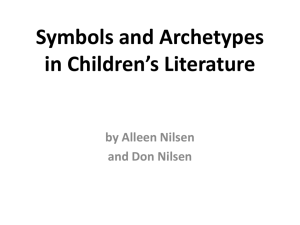
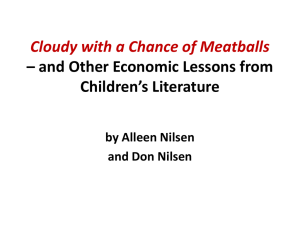

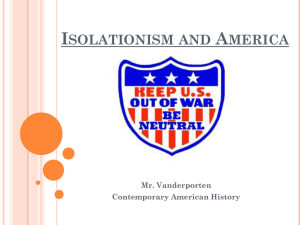
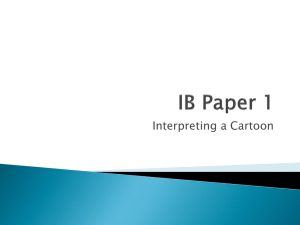
![Phrasal Verbs in Cartoons[2]](http://s2.studylib.net/store/data/005310718_1-897d1a57ddfabbe64c60ba43d0222e3b-300x300.png)
